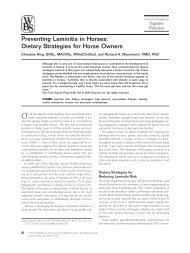Nutritional Secondary Hyperparathyroidism in the Horse
Nutritional Secondary Hyperparathyroidism in the Horse
Nutritional Secondary Hyperparathyroidism in the Horse
You also want an ePaper? Increase the reach of your titles
YUMPU automatically turns print PDFs into web optimized ePapers that Google loves.
14 ’I’he Anatomy of <strong>the</strong> Parathyroid Glands <strong>in</strong> <strong>the</strong> Horsc<br />
The ligh chief cells predom<strong>in</strong>ated <strong>in</strong> horses of all ages. The cells<br />
were arranged <strong>in</strong> small lobuli, often <strong>in</strong> a “rosette” configuration<br />
(Figs. 5 and 8) with a capillary <strong>in</strong> <strong>the</strong> center. The cells were almost<br />
circular <strong>in</strong> outl<strong>in</strong>e, sometimes polyhedric or, more rarely, rectangular.<br />
The cell marg<strong>in</strong>s were variable, sometimes be<strong>in</strong>g poorly def<strong>in</strong>ed and<br />
o<strong>the</strong>r times stand<strong>in</strong>g out well. The cytoplasm was fa<strong>in</strong>tly acidophilic<br />
with hematoxyl<strong>in</strong> and eos<strong>in</strong>, but <strong>the</strong> t<strong>in</strong>ctorial properties varied con-<br />
siderably. With, basic dyes <strong>the</strong> cytoplasm was diffusely and ra<strong>the</strong>r<br />
fa<strong>in</strong>tly blue. T<strong>in</strong>y spherical, more deeply basophilic structures, <strong>the</strong><br />
so-called juxtanuclear bodies, were seen occasionally. They were not<br />
always conf<strong>in</strong>ed to <strong>the</strong> immediate vic<strong>in</strong>ity of <strong>the</strong> nucleus. The nucleus<br />
was well def<strong>in</strong>ed and most often located <strong>in</strong> <strong>the</strong> center. However, <strong>in</strong> <strong>the</strong><br />
above-mentioned rosettes a peripheral location was more common.<br />
One or two nucleoli were present. The size of <strong>the</strong> light chief cell and<br />
its nucleus is given <strong>in</strong> Table I1 and <strong>in</strong> Charts 3 and 4 (for analysis, see<br />
Appendix, Table 11).<br />
Scarlet red sta<strong>in</strong> revealed fat <strong>in</strong> <strong>the</strong> cytoplasm of <strong>the</strong> light chief<br />
cells to <strong>the</strong> degree and frequency shown <strong>in</strong> Table I. In all positive<br />
cases but one, small sudanophilic droplets were present <strong>in</strong> ra<strong>the</strong>r small,<br />
ra<strong>the</strong>r well-circumscribed areas of light chief cells. The fat accumula-<br />
tion was never great enough to give a negative image on <strong>the</strong> embedded<br />
section. In one case, that of a male 8-year-old horse, <strong>the</strong>re was a<br />
diffuse, moderate fatty metamorphosis of practically all light chief cells<br />
<strong>in</strong> <strong>the</strong> section. As may be seen from Table I, parenchymatous fat was<br />
present ma<strong>in</strong>ly <strong>in</strong> adolescent and young adult horses but was very<br />
rarely recorded <strong>in</strong> older horses.<br />
Dark chief cells were rare. They did occur <strong>in</strong> horses of all ages,<br />
however. The size of <strong>the</strong>se cells is given <strong>in</strong> Table 11. The cell outl<strong>in</strong>e<br />
was poorly def<strong>in</strong>ed and <strong>the</strong> cytoplasm was deep purple. The nucleus<br />
was elongated, with <strong>the</strong> length usually double <strong>the</strong> width. It was deeply<br />
and homogeneously basophilic and a nucleolus was <strong>the</strong>refore not<br />
visible. The dark chief cells conta<strong>in</strong>ed no fat.<br />
Water-clear cells occurred at any age, but <strong>the</strong>y were relatively<br />
rare <strong>in</strong> <strong>the</strong> newborn horse <strong>in</strong> this series. In a few horses less than 1 year<br />
of age <strong>the</strong>y were quite frequent, although <strong>the</strong> light chief cells pre-<br />
dom<strong>in</strong>ated. It cannot be said, however, that water-clear cells <strong>in</strong>creased<br />
with age. In some of <strong>the</strong> oldest horses <strong>the</strong>y were relatively scarce.<br />
The water-clear cells were slightly larger than <strong>the</strong> light chief cells<br />
(Table 11). In <strong>the</strong> fully developed stage <strong>the</strong> cytoplasm showed no<br />
aH<strong>in</strong>ity with any sta<strong>in</strong>, but <strong>the</strong> cell outl<strong>in</strong>e was much thicker and better<br />
Downloaded from<br />
vet.sagepub.com by guest on April 14, 2010



